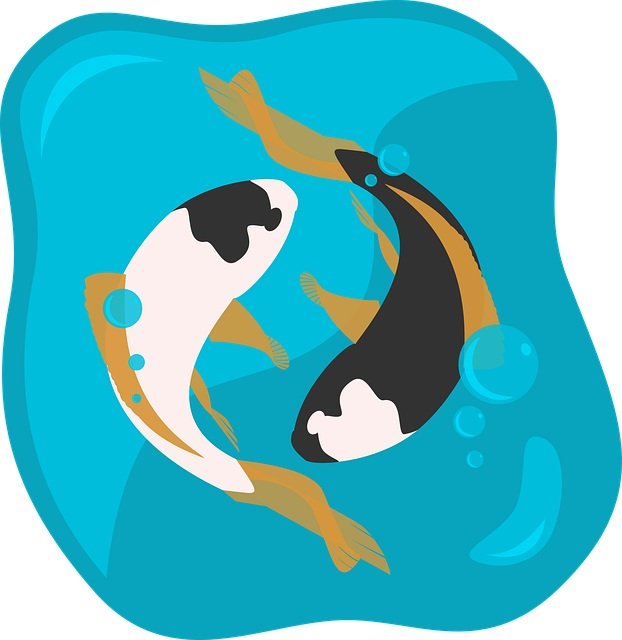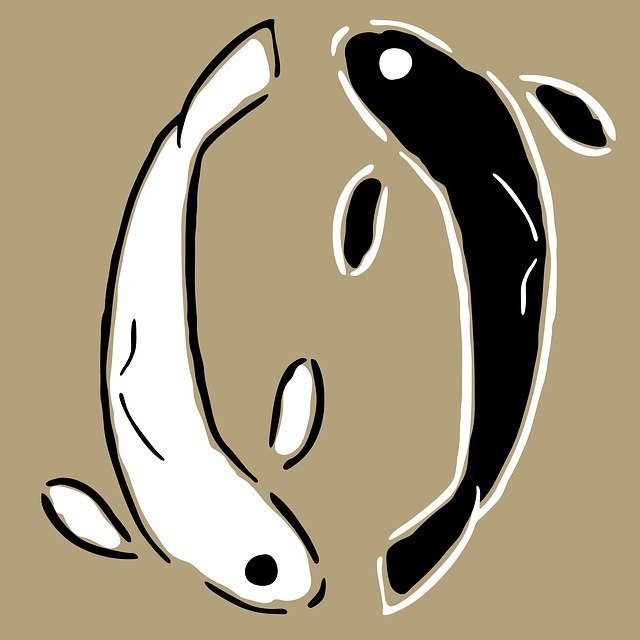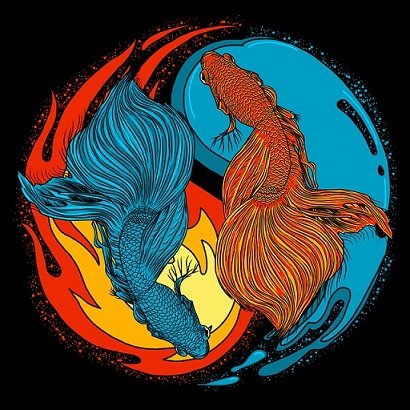If you’ve seen elegant Koi fish swimming in a decorative pond, you’ve probably wondered about the symbolism and significance of these graceful fish. Because Koi fish often have similar coloring, being white with areas of bright orange and sometimes white with black coloring, you may not have initially jumped to the conclusion that Koi are associated with the Yin Yang symbol.
But thanks to an increase in the popularity of Koi fish Yin Yang tattoos, more people are wondering about the connection between these fish and this important symbol of balance.

Often, these artistic renderings of Koi fish are highly stylized to create the semblance of the Yin Yang symbol. In this case, the Yin Koi fish is either black or predominantly black and the Yang Koi fish is likely to be either white or mostly light colored.
Actual Koi fish range in color from pink to gold, to white and red or orange, to silver, white and black, and black. They’ve become associated with ornamental ponds and because of their colorful appearance are thought to be like flowers or gems that adorn waterscapes.
Koi Fish Symbolism:
Koi fish are associated with luck, prosperity, protection, strength, and individuality. They are bred to achieve the unique qualities they possess and are not like other fish. Koi are known to swim tenaciously upstream and can also jump over waterfalls.
Their ability to go against the grain is juxtaposed with their reputation of bold acceptance and courage, when they are caught, they go limp rather than struggling. Some believe this connects the Koi, symbolically, to the strength of the Samurai.
Thus, Koi are associated with people who are regal, unique, and who are willing to go against the grain but also to accept their fate at times. This seeming paradox is also part of the symbolism of Yin and Yang.
Yin Yang Symbolism:
Made popular at different times as a tattoo or as a talisman, the Yin Yang has become ubiquitous. The symbol consists of a circle divided by a curved line, creating two alternately facing teardrop shapes. Within the larger, curved portion of each is a smaller circle. One of the teardrop shapes is usually black while the other is usually white, or at least one light and one dark.
Within each of these teardrops, the smaller circle’s color is that of the opposite teardrop. Thus, the dark or black side contains a white circle, while the white or light color side contains a black or dark circle. This symbol originated as an expression of Taoist belief.
In its simplest terms, this symbol is often associated with balance, yet there is more to it than that. A core aspect of Taoist cosmology is about divine paradox. The creative element in the universe is said to be a self-perpetuating cycle of light and dark feeding into each other.
This is not just about the colors black and white. It is also about the spiritual and mundane, the chaotic and orderly, the passive or receptive, and the active or projective. In other terms, the Yin and Yang are referred to as masculine and feminine principle, but it should be noted this is not about physical anatomy nor gender, but about energy flow.
Yin is the dark or black part of the symbol and represents feminine energy, receptivity, chaos, creativity, intuition and the subconscious. Yang is the light or white part of the symbol, representing masculine energy, activity, projection, order, the mundane, logic, and conscious awareness.
Considered together, this symbol is a reminder that all things found in nature contain some degree of opposing energy or forces. Thus there is nothing that is all good, all bad, all dark, all light and so forth.
When Koi Fish Meet Yin and Yang Symbol:

When the symbolism of Koi is combined with the cosmology represented by the Yin Yang, a powerful symbol is created. Yet there is also a lot of confusion and dilution of the meaning of both of these symbols.
Although Koi fish and Yin Yang are not inherently connected culturally, they have come to be associated with each other in recent years. While Koi fish have great significance in Japan. The word “Koi” is Japanese for Carp as Koi fish are highly bred Carp that date back to early 19th century.
Yet Carp originated in China and was brought to Japan as a gift as far back as 71 AD. Thus, there are a few areas of overlap between Chinese and Japanese culture when it comes to the appreciation of Carp and Koi fish. This cultural blending, and some would say appropriating, is taken further with the proliferation of Koi fish Yin Yang symbols as decoration, jewelry or tattoos.
In Chinese culture, Karp are considered symbols of strength. Combining this with the Yin Yang symbol can represent endurance and acceptance of the paradoxical nature of the universe. This can also mean recognizing the duality in nature and deriving strength from this perspective.
In Japan, Koi are quite important and are associated with all that is positive from strength to luck and prosperity. They are so prominent in Japanese culture that they can be found near shrines.
To combine Koi and Yin Yang blends an important icon from Japanese culture with a core symbol associated with Chinese culture and belief. There is a similar symbol in Japanese culture which represents this divine paradox, called an Inyo. Yet the Inyo looks nothing like the Yin Yang.
The Inyo is a circle that is white on the outside portion and contains a smaller red circle closer to the top. Thus, a Yin Yang created from two Koi swimming in opposite directions takes symbols from two different cultures and combines them.
If your intention is to pay homage to Japanese or Chinese culture specifically, then a Koi Yin Yang tattoo or decoration is off-target. Yet many enjoy the image of the Yin Yang Koi and understand the basic meaning.
Symbolism and Cultural Appropriation

As awareness of cultural appropriation has grown in recent years, some make the case that the Koi Yin Yang is an example of appropriation on a few different levels. The first being the use of significant symbols from two different cultures.
While it’s not harmful to explore various cultures, harm can unintentionally be done when people carelessly borrow images and symbols from cultures they don’t understand. This is especially true if such symbols are put together without a clear understanding of their deeper meaning.
For example, people who wear a Koi Yin Yang symbol without basic understanding of the meaning of each of these symbols or just a basic concept that both are “Asian” are glossing over the distinct differences between Japanese and Chinese cultures.
An argument can also be made for Koi Yin Yang tattoos being appropriative because even the art of tattooing is highly significant in Japanese culture. It is also considered particularly disrespectful to wear a symbol such as Koi Yin Yang without having a deep understanding and respect, both for the symbols and the cultures from which they originate.
Conclusion
While Koi Yin Yang has become popular, many people are confused about the meaning of this combination of symbols from Japanese and Chinese culture. Ultimately, this symbol combines two different sets of meanings. One is the paradoxical nature of all aspects of life and the universe.
The other meaning is drawn from the symbolism of the Koi fish. Koi have many connotations and all are positive. They are associated with luck, longevity, strength, willpower, prosperity and tenacity.
If you are considering wearing this symbol or getting a tattoo of this symbol, be sure to do your research. Understanding, respecting, and appreciating the cultures from which this symbol derives is important.
Angela Kaufman is a Certified Intuitive Consultant, Psychic Medium, Intuitive Empowerment, Life Coach and an LCSW. She is an amazon published author and was Featured on several shows like Discovery Channel’s A Haunting, Echoes from the Past (2007) 14 Degrees: A Paranormal Documentary, Tune In to Wellness Today with LisaMarie Tersigni, and Empowering Entrepreneurs with Melissa Carter as well as numerous radio interviews. She is the author of Queen Up! Reclaim Your Crown When Life Knocks You Down - Unleash the Power of Your Inner Tarot Queen and also co-authored three books on metaphysical spirituality (Sacred Objects, Sacred Space; Everyday Tools for the Modern Day Witch | Wicca What's the Real Deal? Breaking Through the Misconceptions | The Esoteric Dream Book; Mastering the Magickal Symbolism of the Subconscious Mind). Angela regularly conducts workshops, the Inner Queen coaching program and loves writing articles, that blend social criticism with spirituality.
